Numerical Analysis Front Cover THIRD Edition.pdf
Numerical Analysis THIRD Edition Front Matter.pdf
Numerical Analysis THIRD Edition Preface.pdf
Numerical Analysis THIRD Edition TOC All Chapters.pdf
Numerical Analysis THIRD Edition Chapter 01.pdf
Chapter 1
1.1 Command Window
1.2 Roots of Polynomials
1.3 Polynomial Construction from Known Roots
1.4 Evaluation of a Polynomial at Specified Values
1.5 Rational Polynomials
1.6 Using MATLAB to Make Plots
1.7 Subplots
1.8 Multiplication, Division and Exponentiation
1.9 Script and Function Files
1.10 Display Formats
1.11 Summary
1.12 Exercises
1.13 Solutions to End-of-Chapter Exercises
Numerical Analysis THIRD Edition Chapter 02.pdf
Chapter 2
2.1 Newton’s Method for Root Approximation
2.2 Approximations with Spreadsheets
2.3 The Bisection Method for Root Approximation
2.4 Summary
2.5 Exercises
2.6 Solutions to End-of-Chapter Exercises
Numerical Analysis THIRD Edition Chapter 03.pdf
Chapter 3
3.1 Alternating Voltages and Currents
3.2 Characteristics of Sinusoids
3.3 Inverse Trigonometric Functions
3.4 Phasors
3.5 Addition and Subtraction of Phasors
3.6 Multiplication of Phasors
3.7 Division of Phasors
3.8 Exponential and Polar Forms of Phasors
3.9 Summary
3.10 Exercises
3.11 Solutions to End-of-Chapter Exercises
Numerical Analysis THIRD Edition Chapter 04.pdf
Chapter 4
4.1 Matrix Definition
4.2 Matrix Operations
4.3 Special Forms of Matrices
4.4 Determinants
4.5 Minors and Cofactors
4.6 Cramer’s Rule
4.7 Gaussian Elimination Method
4.8 The Adjoint of a Matrix
4.9 Singular and Non-Singular Matrices
4.10 The Inverse of a Matrix
4.11 Solution of Simultaneous Equations with Matrices
4.12 Summary
4.13 Exercises
4.14 Solutions to End-of-Chapter Exercises
Numerical Analysis THIRD Edition Chapter 05.pdf
Chapter 5
5.1 Simple Differential Equations
5.2 Classification
5.3 Solutions of Ordinary Differential Equations (ODE)
5.4 Solution of the Homogeneous ODE
5.5 Using the Method of Undetermined Coefficients for the Forced Response
5.6 Using the Method of Variation of Parameters for the Forced Response
5.7 Expressing Differential Equations in State Equation Form
5.8 Solution of Single State Equations
5.9 The State Transition Matrix
5.10 Computation of the State Transition Matrix
5.11 Eigenvectors
5.12 Summary
5.13 Exercises
5.14 Solutions to End-of-Chapter Exercises
Numerical Analysis THIRD Edition Chapter 06.pdf
Chapter 6
6.1 Wave Analysis
6.2 Evaluation of the Coefficients
6.3 Symmetry
6.4 Waveforms in Trigonometric Form of Fourier Series
6.5 Alternate Forms of the Trigonometric Fourier Series
6.6 The Exponential Form of the Fourier Series
6.7 Line Spectra
6.8 Numerical Evaluation of Fourier Coefficients
6.9 Power Series Expansion of Functions
6.10 Taylor and Maclaurin Series
6.11 Summary
6.12 Exercises
6.13 Solutions to End-of-Chapter Exercises
Numerical Analysis THIRD Edition Chapter 07.pdf
Chapter 7
7.1 Divided Differences
7.2 Factorial Polynomials
7.3 Antidifferences
7.4 Newton’s Divided Difference Interpolation Method
7.5 Lagrange’s Interpolation Method
7.6 Gregory-Newton Forward Interpolation Method
7.7 Gregory-Newton Backward Interpolation Method
7.8 Interpolation with MATLAB
7.9 Summary
7.10 Exercises
7.11 Solutions to End-of-Chapter Exercises
Numerical Analysis THIRD Edition Chapter 08.pdf
Chapter 8
8.1 Curve Fitting
8.2 Linear Regression
8.3 Parabolic Regression
8.4 Regression with Power Series Approximations
8.5 Summary
8.6 Exercises
8.7 Solutions to End-of-Chapter Exercises
Numerical Analysis THIRD Edition Chapter 09.pdf
Chapter 9
9.1 Taylor Series Method
9.2 Runge-Kutta Method
9.3 Adams’ Method
9.4 Milne’s Method
9.5 Summary
9.6 Exercises
9.7 Solutions to End-of-Chapter Exercises
Numerical Analysis THIRD Edition Chapter 10.pdf
Chapter 10
10.1 The Trapezoidal Rule
10.2 Simpson’s Rule
10.3 Summary
10.4 Exercises
10.5 Solution to End-of-Chapter Exercises
Numerical Analysis THIRD Edition Chapter 11.pdf
Chapter 11
11.1 Introduction
11.2 Definition, Solutions, and Applications
11.3 Fibonacci Numbers
11.4 Summary
11.5 Exercises
11.6 Solutions to End-of-Chapter Exercises
Numerical Analysis THIRD Edition Chapter 12.pdf
Chapter 12
12.1 Partial Fraction Expansion
12.2 Alternate Method of Partial Fraction Expansion
12.3 Summary
12.4 Exercises
12.5 Solutions to End-of-Chapter Exercises
Numerical Analysis THIRD Edition Chapter 13.pdf
Chapter 13
13.1 The Gamma Function
13.2 The Gamma Distribution
13.3 The Beta Function
13.4 The Beta Distribution
13.5 Summary
13.6 Exercises
13.7 Solutions to End-of-Chapter Exercises
Numerical Analysis THIRD Edition Chapter 14.pdf
Chapter 14
14.1 Orthogonal Functions
14.2 Orthogonal Trajectories
14.3 Orthogonal Vectors
14.4 The Gram-Schmidt Orthogonalization Procedure
14.5 The LU Factorization
14.6 The Cholesky Factorization
14.7 The QR Factorization
14.8 Singular Value Decomposition
14.9 Summary
14.10 Exercises
14.11 Solutions to End-of-Chapter Exercises
Numerical Analysis THIRD Edition Chapter 15.pdf
Chapter 15
15.1 The Bessel Function
15.2 Legendre Functions
15.3 Laguerre Polynomials
15.4 Chebyshev Polynomials
15.5 Summary
15.6 Exercises
15.7 Solutions to End-of-Chapter Exercises
Numerical Analysis THIRD Edition Chapter 16.pdf
Chapter 16
16.1 Linear Programming
16.2 Dynamic Programming
16.3 Network Analysis
16.4 Summary
16.5 Exercises
16.6 Solutions to End-of-Chapter Exercises
Numerical Analysis THIRD Edition Appendix A Difference Equations.pdf
Appendix A
A.1 Recursive Method for Solving Difference Equations
A.2 Method of Undetermined Coefficients
Numerical Analysis THIRD Edition Appendix B Introduction to Simulink.pdf
Appendix B
B.1 Simulink and its Relation to MATLAB
B.2 Simulink Demos
Numerical Analysis THIRD Edition Appendix C Ill-Conditioned Matrices.pdf
Appendix C
Ill-Conditioned Matrices
his appendix supplements Chapters 4 and 14 with concerns when the determinant of the coefficient matrix is small. We will introduce a reference against which the determinant can be measured to classify a matrix as a well- or ill-conditioned.
C.1 The Norm of a Matrix
A norm is a function which assigns a positive length or size to all vectors in a vector space, other than the zero vector. An example is the two-dimensional Euclidean space denoted as . The elements of the Euclidean vector space (e.g., (2,5))...
The Euclidean norm of a matrix , denoted as , is defined as
(C.1)
and it is computed with the MATLAB function norm(A).
Example C.1
Using the MATLAB function norm(A), compute the Euclidean norm of the matrix , defined as
Solution:
At the MATLAB command prompt, we enter
A=[-2 5 -4 9; -3 -6 8 1; 7 -5 3 2; 4 -9 -8 -1]; norm(A)
and MATLAB outputs
ans =
14.5539
C.2 Condition Number of a Matrix
The condition number of a matrix is defined as
(C.2)
where is the norm of the matrix defined in relation (C.1) above. Matrices with condition number close to unity are said to be well-conditioned matrices, and those with very large condition number are said to be ill-conditioned matrices.
The condition number of a matrix is computed with the MATLAB function cond(A).
Example C.2
Using the MATLAB function cond(A), compute the condition number of the matrix defined as
Solution:
At the MATLAB command prompt, we enter
A=[-2 5 -4 9; -3 -6 8 1; 7 -5 3 2; 4 -9 -8 -1]; cond(A)
and MATLAB outputs
ans =
2.3724
This condition number is relatively close to unity and thus we classify matrix A as a well-condi tioned matrix.
We recall from Chapter 4 that if the determinant of a square matrix A is singular, that is, if , the inverse of A is undefined. Please refer to Chapter 4, Page 4-22.
Now, let us consider that the coefficient matrix is very small, i.e., almost singular. Accordingly, we classify such a matrix as ill-conditioned.
C.3 Hilbert Matrices
Let be a positive integer. A unit fraction is the reciprocal of this integer, that is, . Thus, are unit fractions. A Hilbert matrix is a matrix with unit fraction elements
(C.3)
(C.4)
MATLAB’s function hilb(n) displays the Hilbert matrix.
Example C.3
Compute the determinant and the condition number of the Hilbert matrix using MATLAB.
Solution:
At the MATLAB command prompt, we enter
det(hilb(6))
and MATLAB outputs
ans =
5.3673e-018
This is indeed a very small number and for all practical purposes this matrix is singular.
We can find the condition number of a matrix A with the cond(A) MATLAB function. Thus, for the Hilbert matrix,
cond(hilb(6))
ans =
1.4951e+007
This is a large number and if the coefficient matrix is multiplied by this number, seven decimal places might be lost.
Let us consider another example.
Example C.4
Let where and
Compute the values of the vector .
Solution:
Here, we are asked to find the values of and of the linear system
Using MATLAB, we define and , and we use the left division operation, i.e.,
A=[0.585 0.378; 0.728 0.464]; b=[0.187 0.256]'; x=b\A
x =
2.9428 1.8852
Check:
A=[0.585 0.378; 0.728 0.464]; x=[2.9428 1.8852]'; b=A*x
b =
2.4341
3.0171
but these are not the given values of the vector , so let us check the determinant and the condi tion number of the matrix .
determinant = det(A)
determinant =
-0.0037
condition=cond(A)
condition =
328.6265
Therefore, we conclude that this system of equations is ill-conditioned and the solution is invalid.
Example C.4 above should serve as a reminder that when we solve systems of equations using matrices, we should check the determinants and the condition number to predict possible floating point and roundoff errors.
Numerical Analysis book Bibliography.pdf
References and Suggestions for Further Study
A. The following publications by The MathWorks, are highly recommended for further study. They are available from The MathWorks, 3 Apple Hill Drive, Natick, MA, 01760, www.mathworks.com.
1. Getting Started with MATLAB
2. Using MATLAB
3. Using MATLAB Graphics
4. Financial Toolbox
5. Statistics Toolbox
B. Other references indicated in footnotes throughout this text, are listed below.
1. Mathematics for Business, Science, and Technology with MATLAB and Excel Computations, Third Edition, ISBN-13: 978-1-934404-01-2
2. Circuit Analysis I with MATLAB Applications, ISBN 0-9709511-2-4
6. Handbook of Mathematical Functions, ISBN 0-4866127-2-4
7. CRC Standard Mathematical Tables, ISBN 0-8493-0626-4
Numerical Analysis, 3rd Edition Index All Chapters.pdf

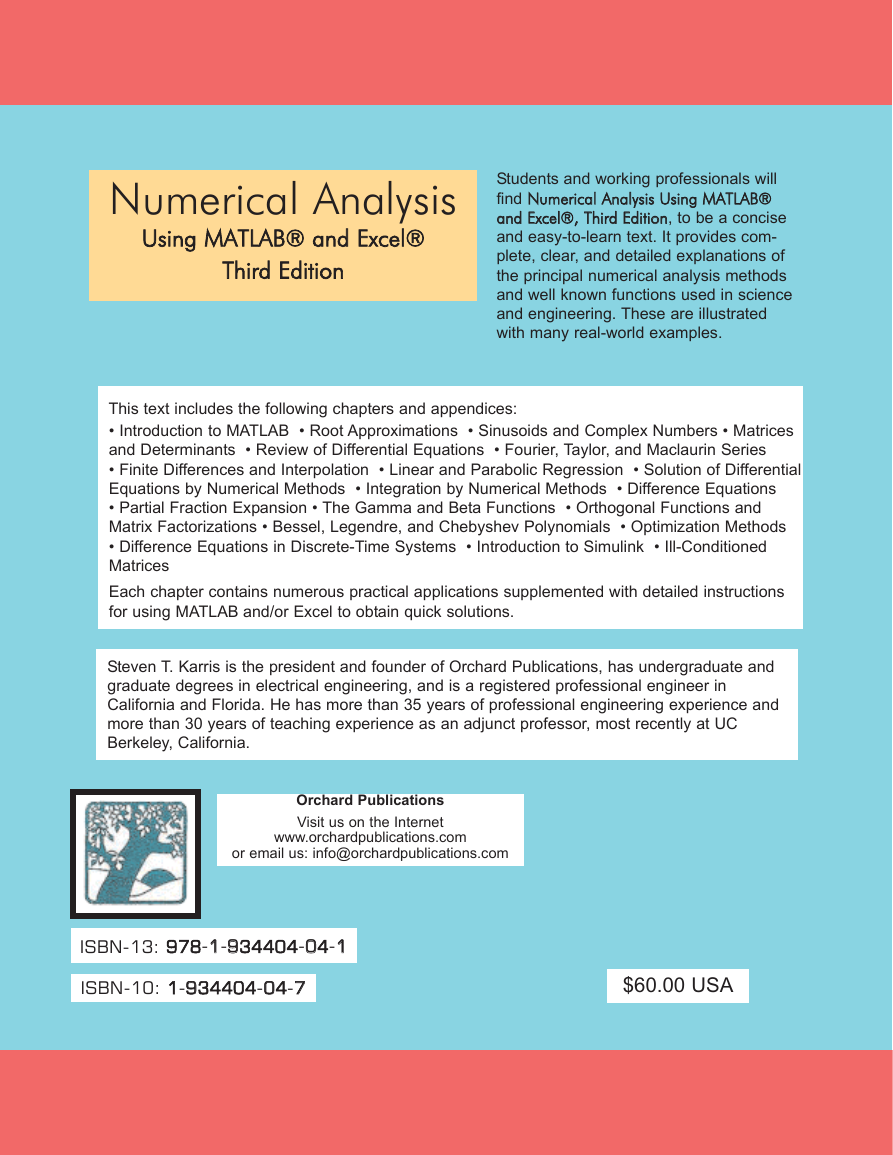
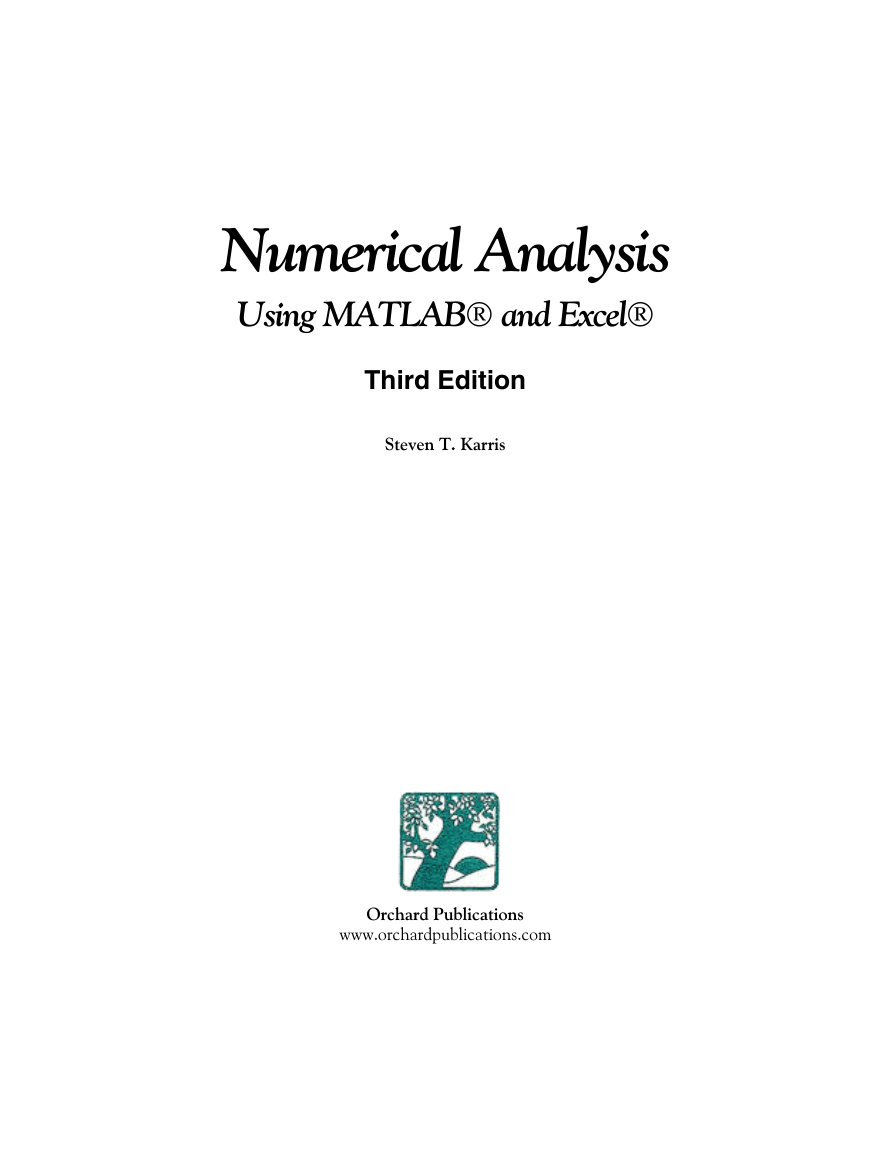
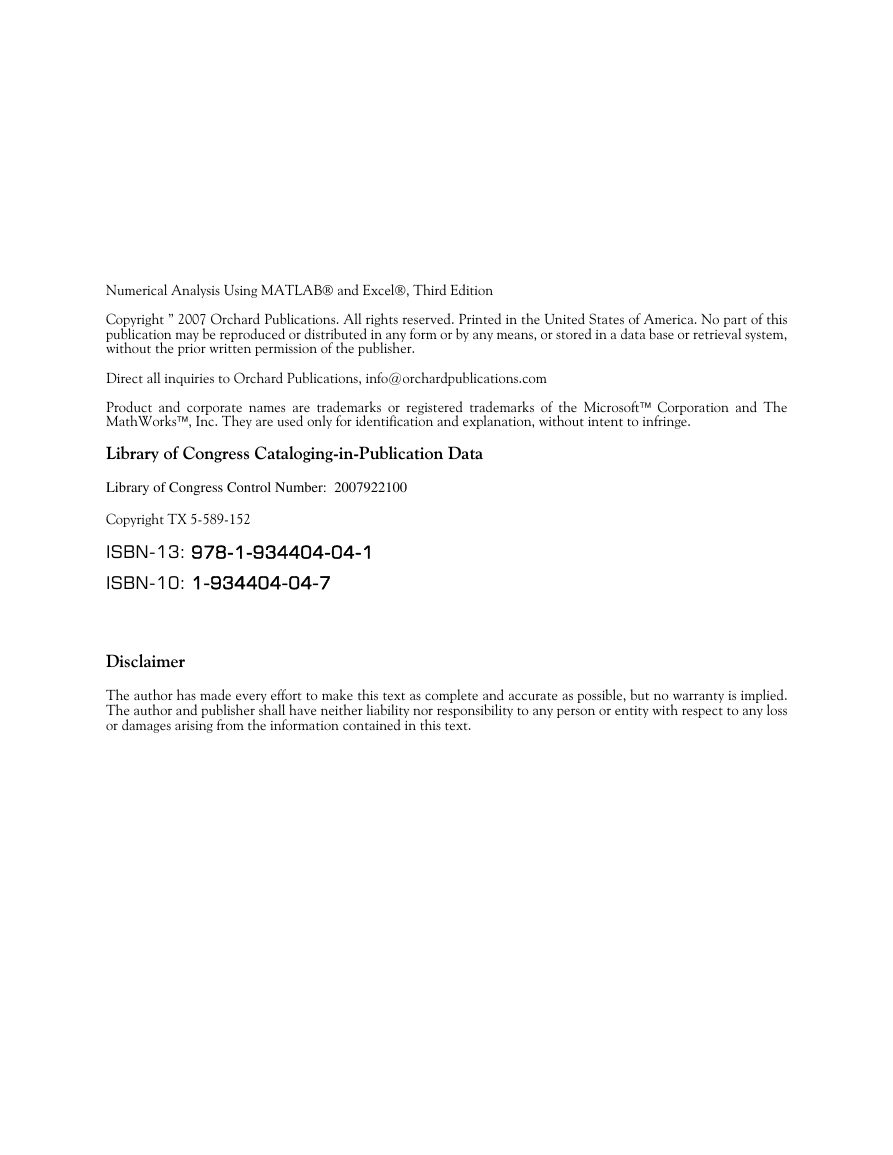
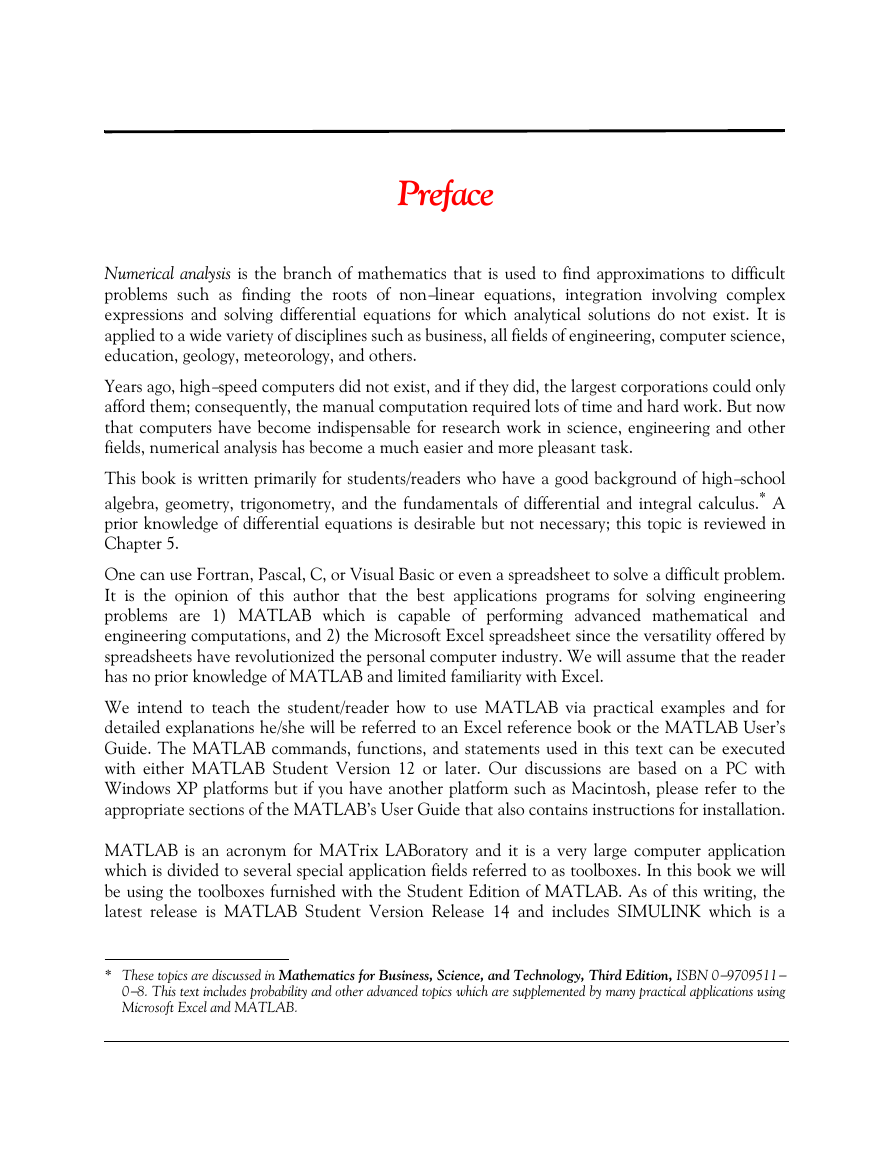
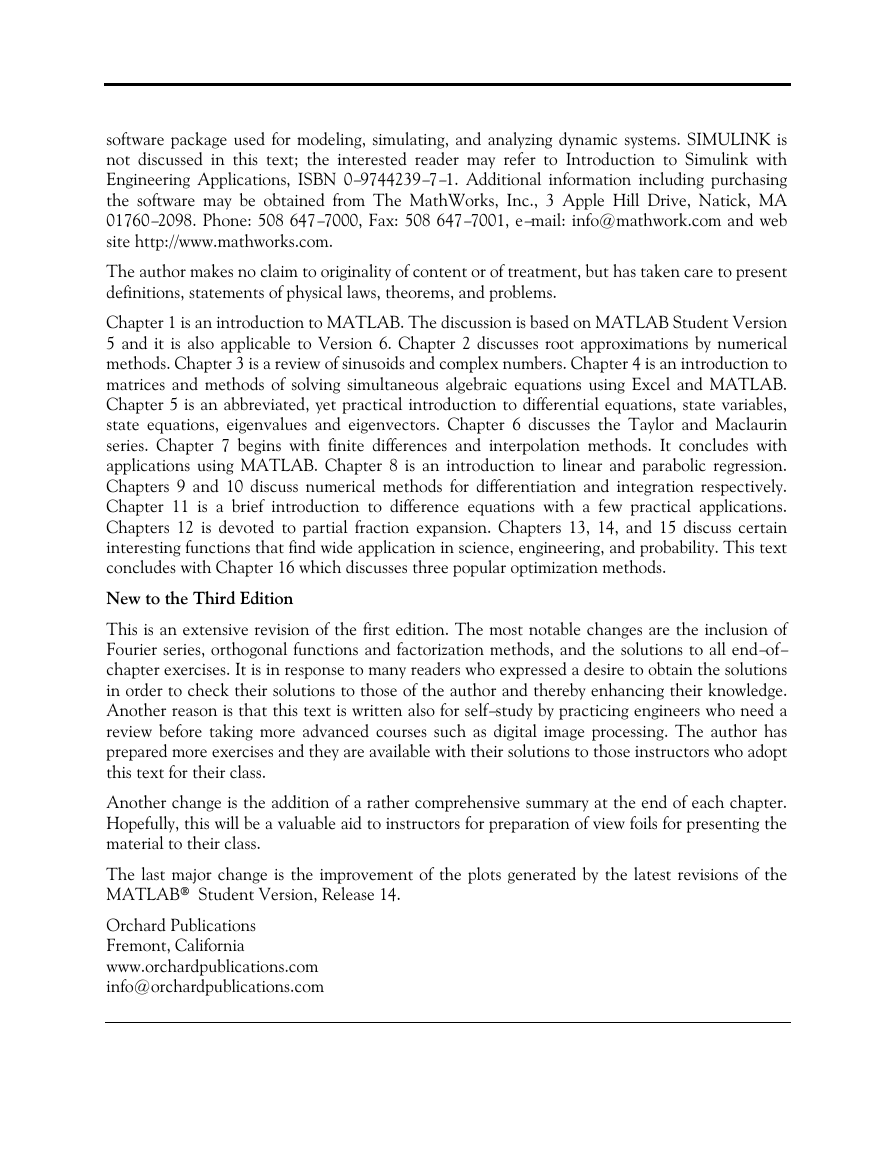
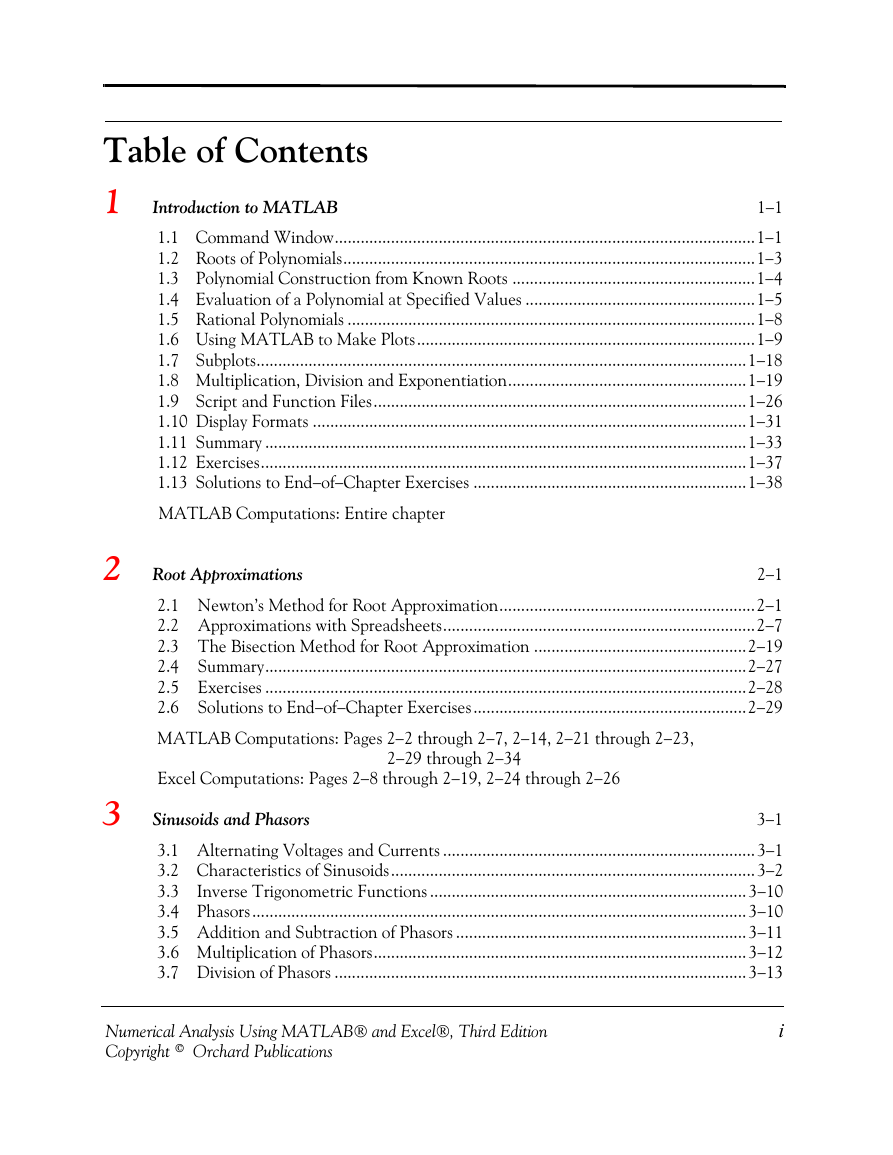
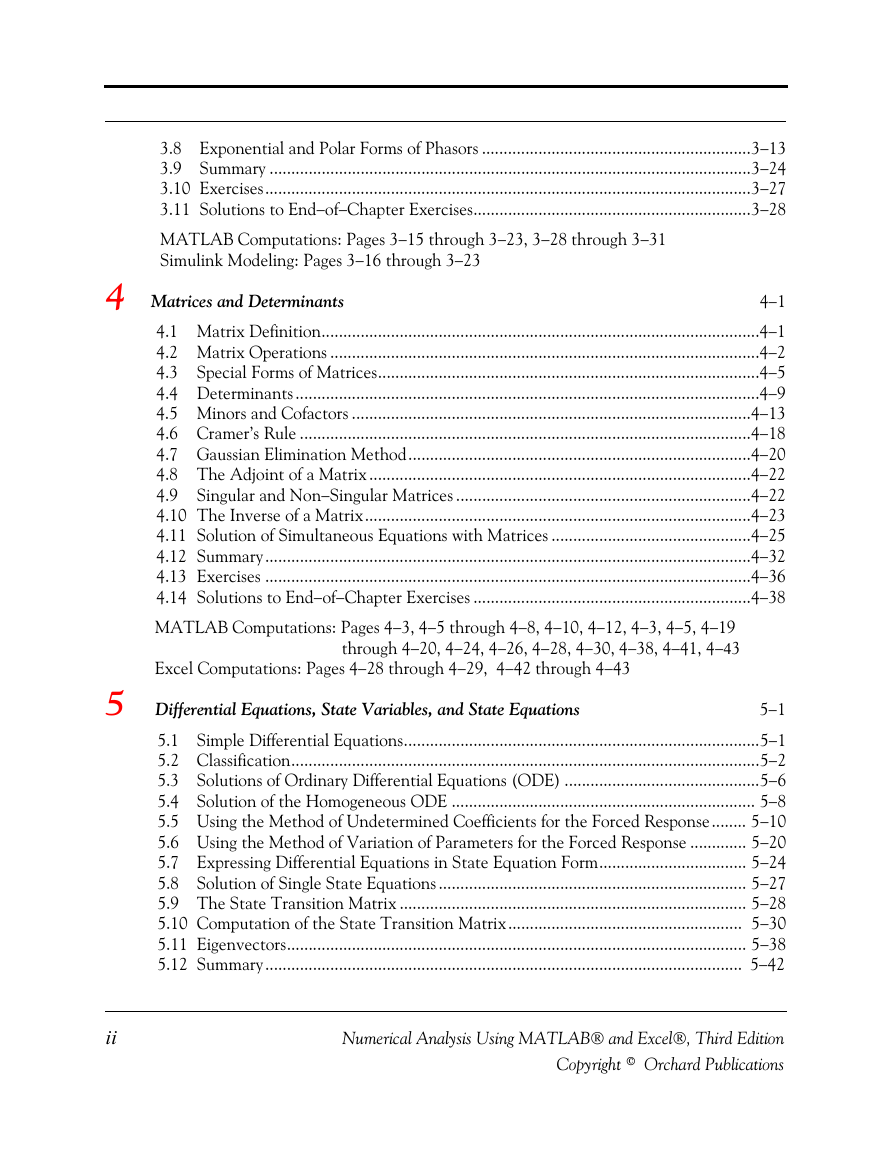








 2023年江西萍乡中考道德与法治真题及答案.doc
2023年江西萍乡中考道德与法治真题及答案.doc 2012年重庆南川中考生物真题及答案.doc
2012年重庆南川中考生物真题及答案.doc 2013年江西师范大学地理学综合及文艺理论基础考研真题.doc
2013年江西师范大学地理学综合及文艺理论基础考研真题.doc 2020年四川甘孜小升初语文真题及答案I卷.doc
2020年四川甘孜小升初语文真题及答案I卷.doc 2020年注册岩土工程师专业基础考试真题及答案.doc
2020年注册岩土工程师专业基础考试真题及答案.doc 2023-2024学年福建省厦门市九年级上学期数学月考试题及答案.doc
2023-2024学年福建省厦门市九年级上学期数学月考试题及答案.doc 2021-2022学年辽宁省沈阳市大东区九年级上学期语文期末试题及答案.doc
2021-2022学年辽宁省沈阳市大东区九年级上学期语文期末试题及答案.doc 2022-2023学年北京东城区初三第一学期物理期末试卷及答案.doc
2022-2023学年北京东城区初三第一学期物理期末试卷及答案.doc 2018上半年江西教师资格初中地理学科知识与教学能力真题及答案.doc
2018上半年江西教师资格初中地理学科知识与教学能力真题及答案.doc 2012年河北国家公务员申论考试真题及答案-省级.doc
2012年河北国家公务员申论考试真题及答案-省级.doc 2020-2021学年江苏省扬州市江都区邵樊片九年级上学期数学第一次质量检测试题及答案.doc
2020-2021学年江苏省扬州市江都区邵樊片九年级上学期数学第一次质量检测试题及答案.doc 2022下半年黑龙江教师资格证中学综合素质真题及答案.doc
2022下半年黑龙江教师资格证中学综合素质真题及答案.doc